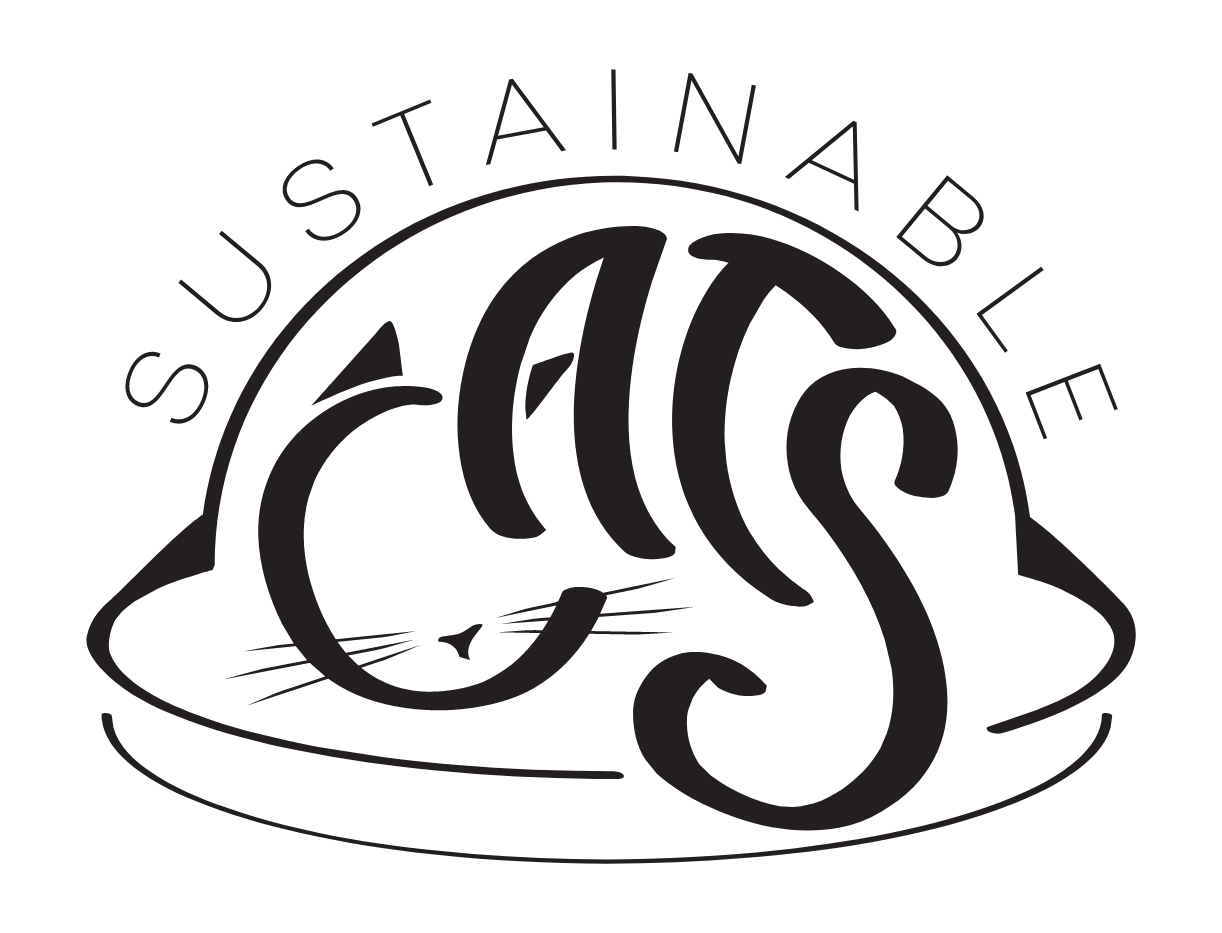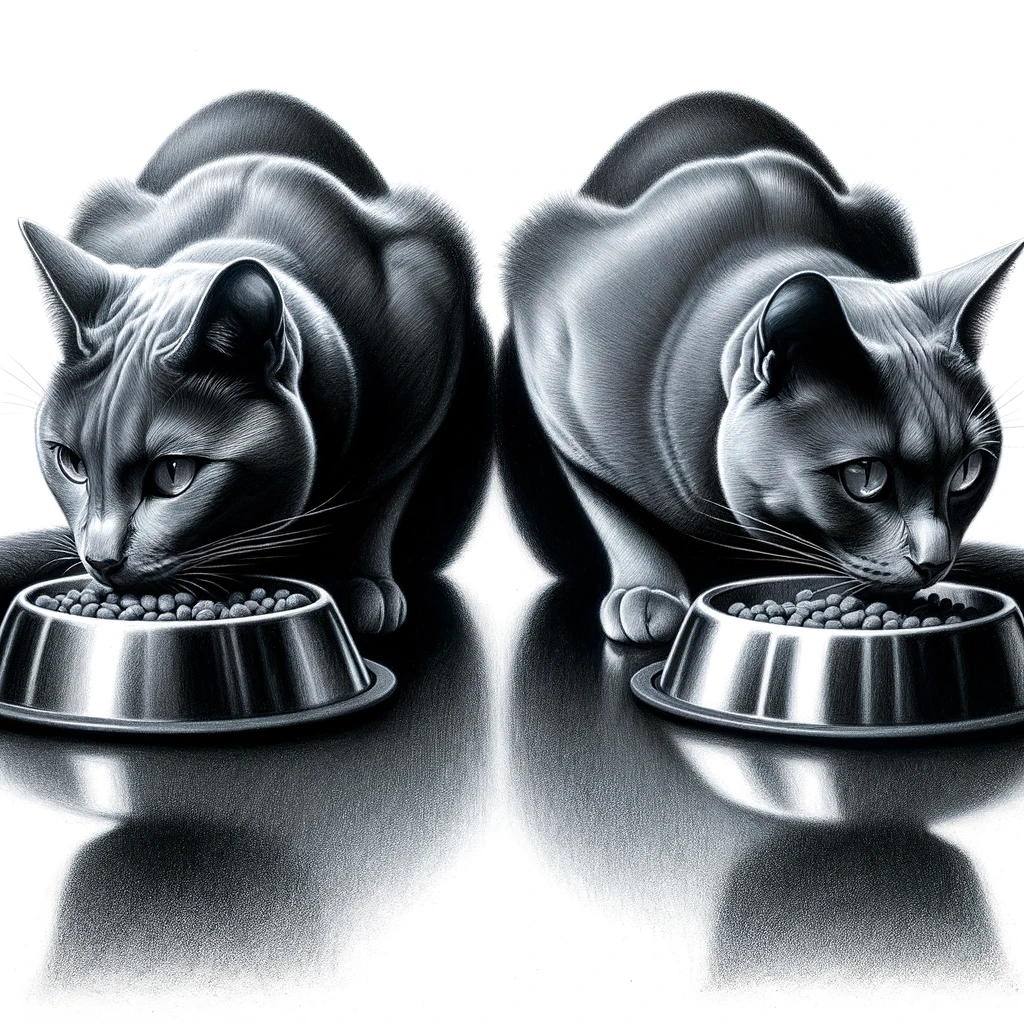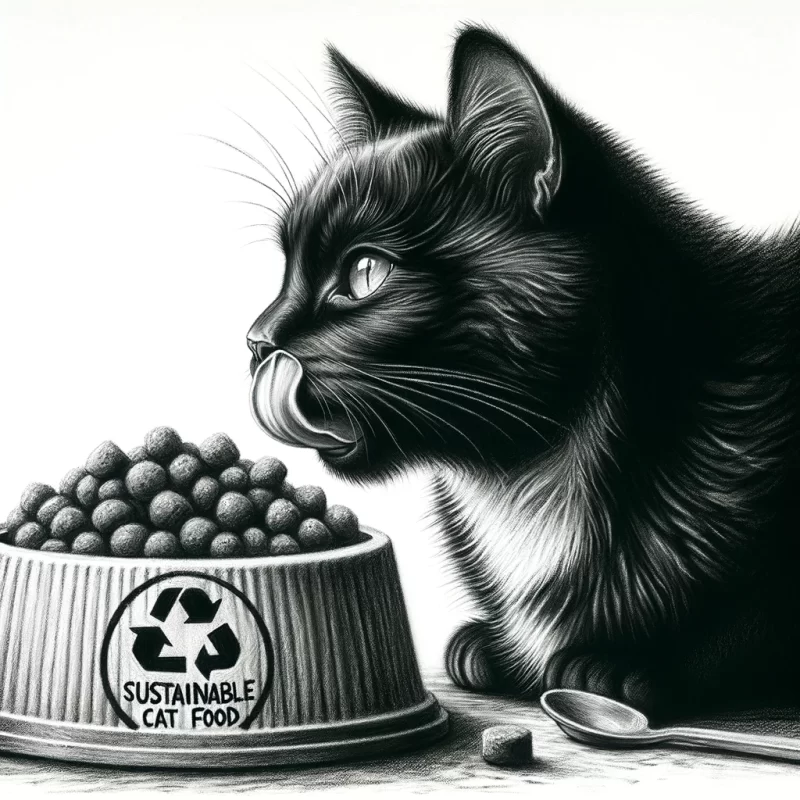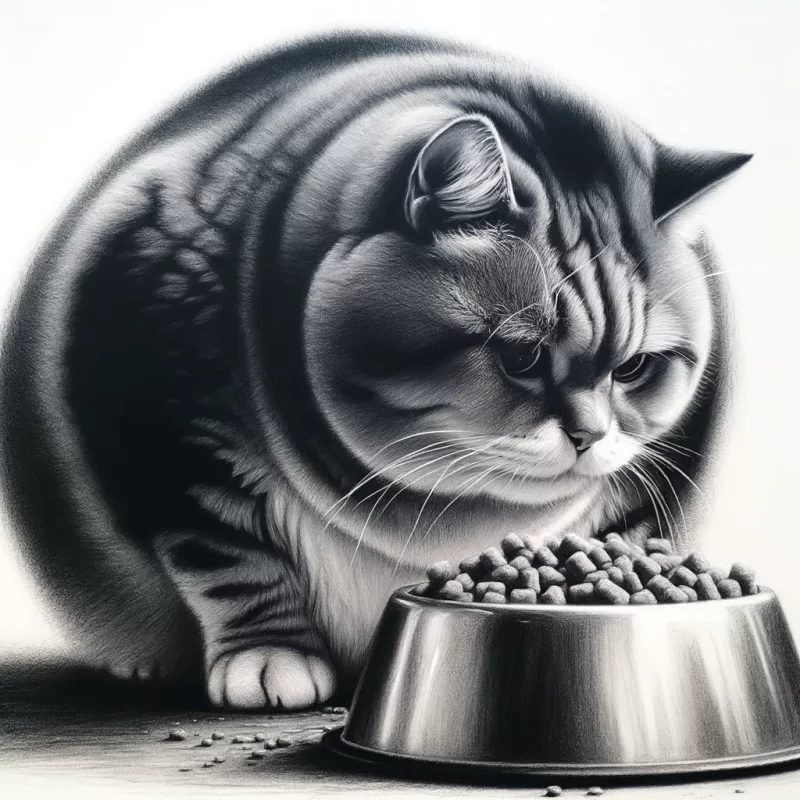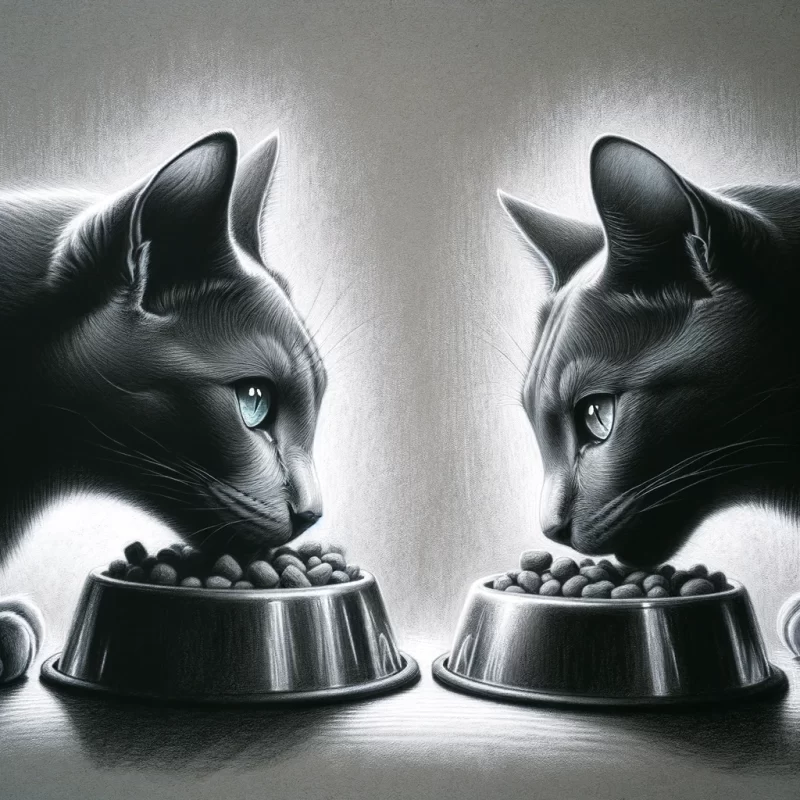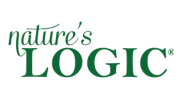Navigating the Dilemmas: Choosing Between Organic and Sustainable Cat Food
As cat owners, we want the best for our feline companions. We strive to provide them with a diet that is not only nutritious but also aligns with our values and beliefs. In recent years, the rise in awareness about the impact of food production on the environment and our health has led to an increased demand for organic and sustainable cat food. However, choosing between these options can often be riddled with dilemmas and marketing traps. In this chapter, we will explore cat owners’ challenges when making this choice and discuss strategies to discern our buying endeavours better.
The Organic Conundrum
Organic cat food has gained popularity due to its promise of being free from synthetic pesticides, fertilisers, and GMOs. It appeals to cat owners prioritising natural and chemical-free ingredients in their pet’s diet. However, the term “organic” can sometimes be misleading. With the increasing demand for organic products, some manufacturers may only use the label if they adhere to strict organic standards. This marketing trap can make it challenging for cat owners to differentiate between genuinely organic cat food and those simply capitalising on the trend.
The Sustainability Puzzle
On the other hand, sustainable cat food focuses on the environmental impact of the entire production process. It considers factors such as packaging, transportation, and waste management. Sustainable cat food aims to minimise the carbon footprint associated with the production and distribution of pet food. However, determining a product’s sustainability can be complex. The lack of standardised certifications and varying definitions of sustainability make it difficult for cat owners to make informed choices.
Unraveling the Marketing Traps
In the world of cat food, marketing tactics can often cloud our judgment and lead us astray. Labels adorned with buzzwords like “natural,” “eco-friendly,” or “green” can create an illusion of sustainability or organic quality. However, it is crucial to look beyond the marketing claims and delve deeper into the ingredients, sourcing practices, and production methods. By educating ourselves about the different certifications and understanding what they truly mean, we can better navigate the marketing traps and make more informed decisions.
Strategies for Discerning Buyers
To become discerning buyers, there are several strategies we can employ when choosing between organic and sustainable cat food. Firstly, it is essential to research and familiarise ourselves with reputable certifications such as USDA Organic, Non-GMO Project Verified, or the Global Animal Partnership (GAP) certification. These certifications provide a level of assurance that the product meets specific standards.
Secondly, we should scrutinise the ingredient list and look for transparency in sourcing. Organic cat food should contain certified organic ingredients, while sustainable cat food should prioritise responsibly sourced ingredients. Examining the packaging materials and the company’s commitment to reducing waste can provide insights into their sustainability practices.
Lastly, seeking independent reviews and recommendations from trusted sources can help us make more informed choices. Hearing from other cat owners who have navigated the organic and sustainable cat food landscape can provide valuable insights and help us avoid potential pitfalls.
The Decision to Choose Between Organic and Sustainable Cat Food is a Challenging One
The marketing traps and lack of standardised definitions make it difficult for cat owners to discern the best option for their pets. However, we can become more discerning buyers by educating ourselves, scrutinising labels, and seeking reliable information. In the following chapters, we will delve deeper into the intricacies of organic and sustainable cat food, exploring the benefits, drawbacks, and considerations to help you make the best decision for your beloved feline companion.
Understanding Organic Cat Food
Organic cat food epitomises a production philosophy that underscores using ingredients cultivated without synthetic pesticides, fertilisers, or genetically modified organisms (GMOs). As such, it aligns with the ethos of environmental stewardship and the preservation of natural resources. The certification of organic cat food necessitates adherence to stringent regulations, which are intended to support agricultural methods that foster soil integrity and ecological balance.
However, organic certification primarily concentrates on the production method rather than the product lifecycle’s holistic environmental impact. Therefore, while organic cat food is often perceived as environmentally friendly, it does not automatically guarantee a minimal carbon footprint or optimised resource utilisation, elements quintessential to true sustainability.
Definition and Certification Standards
Organic cat food signifies adherence to rigorous agronomic practices devoid of synthetic interventions.
Organic certification ensures ecological integrity but doesn’t encapsulate the product’s environmental impact.
Cat food must comply with established government standards regulating production processes, inputs, and labelling to attain organic status.
Certification evaluates compliance with organic principles, not necessarily long-term sustainability measures such as carbon footprint or water usage.
Ingredients and Sourcing Practices
Organic cat food prioritises natural ingredients, free from synthetic additives or pesticides. This approach promotes biodiversity and nurtures soil health, contributing to environmental stewardship.
In 2017, leading brands adopted regenerative farming practices, enhancing soil fertility and capturing atmospheric carbon, thus aligning closely with sustainability principles.
Yet, it’s pivotal to discern whether a product’s sourcing methods support local ecosystems and economic structures, fostering resilience and reducing transportation-related emissions.
Beyond the farm gate, transparency in the supply chain is crucial; fair trade certifications signify socio-economic considerations, essential for enveloping sustainability beyond mere environmental facets.
Thus, organic production may tread lightly on the earth, but the sustainability mantle is a broader covenant that demands judicious scrutiny.
Evaluating Environmental Impact
The environmental impact of organic cat food involves a multi-faceted analysis that extends beyond the mere absence of synthetic chemicals in production. A genuinely sustainable product necessitates a holistic assessment encompassing the lifecycle analysis of the food—from raw material sourcing to packaging and distribution. To ascertain environmental sustainability, one must evaluate the efficiency of resource utilisation, the extent of emissions throughout the supply chain, and the ultimate biodegradability of the product. Only then can organic cat food be deemed as an ally rather than an adversary to our delicate ecosystems.
Choosing organic cat food is a logical step towards sustainability. Still, it’s essential to understand that organic does not automatically guarantee a minimal carbon footprint or optimised resource utilisation. Organic certification focuses primarily on the production method, ensuring the use of ingredients cultivated without synthetic pesticides, fertilisers, or GMOs. While this aligns with environmental stewardship, it doesn’t encompass the product’s environmental impact.
To achieve organic status, cat food must adhere to strict government standards that regulate production processes, inputs, and labelling. Certification evaluates compliance with organic principles but doesn’t necessarily consider long-term sustainability measures like carbon footprint or water usage.
Organic cat food prioritises natural ingredients and promotes biodiversity while nurturing soil health. Leading brands have even adopted regenerative farming practices, enhancing soil fertility and capturing carbon. However, it’s essential to consider whether a product’s sourcing methods support local ecosystems and economic structures, reducing transportation emissions and fostering resilience.
Beyond the farm gate, transparency in the supply chain is crucial. Fairtrade certifications indicate socio-economic considerations, going beyond environmental aspects and encompassing sustainability.
Evaluating the environmental impact of organic cat food requires a comprehensive analysis of the entire lifecycle. This includes assessing resource utilisation efficiency, emissions throughout the supply chain, and the product’s biodegradability. By considering these factors, we can only determine if organic cat food truly supports our delicate ecosystems and contributes to sustainability.
Organic Farming vs. Conventional Methods: Understanding the Differences
Organic agriculture prioritises ecosystem health, embracing methods that enhance soil fertility and biodiversity. In contrast, conventional farming often relies on synthetic fertilisers and pesticides, which can have long-term detrimental effects on the environment and, potentially, human health.
Conventional approaches may yield larger crops more quickly but typically come at a higher environmental cost. Organic and conventional farming methods have distinct differences in their approach to agriculture. Organic farming prioritises the health of ecosystems and employs practices that enhance soil fertility and biodiversity. In contrast, conventional farming often relies on synthetic fertilisers and pesticides, which can have long-term detrimental effects on the environment and, potentially, human health.
While conventional farming methods may yield larger crops more quickly, they typically come at a higher environmental cost. Using synthetic chemicals can pollute water bodies, deplete soil nutrients, and harm beneficial organisms like pollinators.
On the other hand, organic farming promotes natural, chemical-free cultivation approaches. It emphasises using organic fertilisers, crop rotation, and biological pest control methods. These practices help maintain soil health, conserve water resources, and protect biodiversity by avoiding synthetic chemicals that can harm non-target organisms.
Choosing organic cat food means supporting organic farming practices. Doing so contributes to the conservation of ecosystems and the reduction of pollution associated with conventional farming methods. However, it’s important to note that organic certification primarily focuses on production methods and does not guarantee optimised resource utilisation or minimal carbon footprint.
Understanding the differences between organic farming and conventional methods allows consumers to make informed decisions about the cat food they choose and its environmental impact.
Organic practices can decrease pollution, conserve water, reduce soil erosion, and increase soil fertility. They are implemented in harmony with nature instead of imposing upon it, fostering a more sustainable balance between food production and environmental stewardship.
The disparity between organic and conventional methods extends to the broader ecological footprint. Traditional practices may lead to nutrient runoff and water contamination, whereas organic methods aim to maintain environmental equilibrium. Advocates of organic farming assert that if scaled appropriately, it posits a more sustainable avenue for long-term food production—this includes cat food manufacture, where the ultimate goal is to procure nutritionally adequate feed with minimal environmental encroachment.
Packaging and Distribution Footprint
Organic pet food’s sustainability extends beyond cultivation and manufacturing processes. The environmental impact of packaging plays a vital role in the sustainability narrative. Traditional plastic containers and non-recyclable materials used in packaging contribute significantly to ecological strain, diminishing the potential benefits of organic sourcing.
In contrast, eco-friendly packaging solutions, such as biodegradable or recyclable materials, complement organic products by reducing waste and resource consumption. A rising number of organic cat food brands are thus adopting such materials, enabling a closed-loop system that enhances overall sustainability. However, the totality of a product’s sustainability is not solely defined by its packaging materials but also by the efficiencies of the production and distribution networks.
The carbon footprint of distribution is a critical yet often overlooked element. Optimally, food should be sourced and sold locally to minimise transportation emissions. Unfortunately, the expansive distribution networks required to supply organic cat food nationally or globally inherently increase fossil fuel consumption and greenhouse gas emissions, potentially eclipsing the benefits derived from organic practices.
Moreover, sustainable logistics practices, like efficient route planning and using alternative fuel vehicles, can mitigate these adverse effects. As the organic cat food market grows, there is significant scope for innovation in sustainable distribution methods. Investment in such logistical improvements is crucial for diminishing the ecosystemic impacts of the organic pet food industry.
To achieve true sustainability, all facets of production, including the transit of finished products, must be scrutinised and optimised. Thus, while organic cat food may be inherently more eco-friendly, its sustainability must also be evaluated in the context of its packaging and distribution footprints.
Organic Cat Food vs. Sustainable Cat Food: Clearing the Confusion
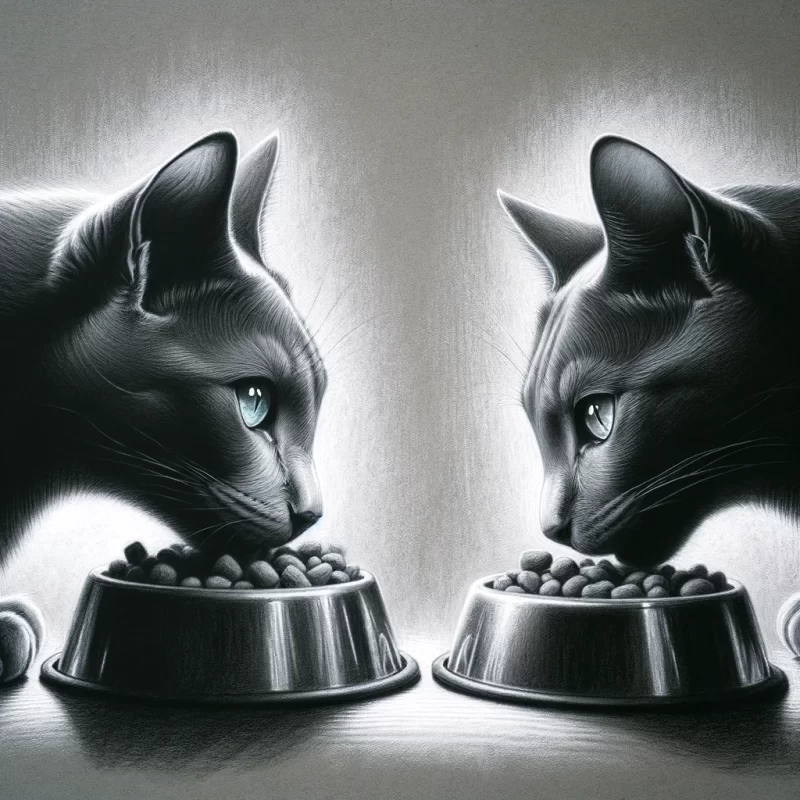
Organic cat food epitomises products derived from methods emphasising natural processes and inputs, ostensibly conducive to environmental health. However, organic certification primarily concerns agricultural practices rather than the comprehensive lifecycle that underpins true sustainability. Hence, an organic label does not inherently guarantee that a product is cultivated with a minimised ecological footprint.
Distinctly, sustainability transcends the scope of organic by embracing a holistic paradigm, wherein the entire supply chain, including resource extraction, production methodologies, packaging, and distribution, is orchestrated to reduce environmental impact. Therefore, the nexus between organic and sustainable reaches a confluence only when organic practices intertwine with stringent sustainability standards across a product’s complete lifecycle.
Key Differences in Definitions
Organic denotes agricultural practices that avoid synthetic chemicals and genetically modified organisms, fostering ecological balance and biodiversity conservation. However, these criteria only encompass part of the spectrum of environmental stewardship.
Sustainability, by contrast, demands a comprehensive approach to ecological conservation, encompassing efficient resource use throughout a product’s lifecycle.
Organic certification is a meticulous process that verifies that foodstuffs have been produced according to specific agronomic standards. Yet, this certification is silent on matters such as carbon output, water usage, and social equity, which are core facets of sustainability.
In their quintessence, sustainable practices pursue the equilibrium between ecological integrity, economic viability, and social welfare, seeking to minimise negative impacts and to engender a restorative cycle. Sustainability’s crux lies in its systems-oriented lens, reflecting a commitment across a product’s lifecycle from sourcing to disposal. The nuance here is critical; while the organic paradigm can contribute to sustainability, it is not a surrogate for the holistic approach that sustainability embodies.
Can Organic Also Be Unsustainable?
Organic cat food often constitutes ingredients grown without synthetic pesticides, fertilisers, or genetically modified organisms, reducing certain environmental toxins. However, the designation ‘organic’ does not inherently guarantee that its production conserves biodiversity or minimises energy consumption.
Organic food production may still involve unsustainable practices such as water-intensive agriculture or soil-depleting cultivation techniques.
Moreover, if organic products are transported long distances, the ensuing carbon emissions (from transportation and distribution activities) could offset the environmental benefits.
Some organic cat food sources may depend on monocultures, which, while organically managed, still pose risks to soil health and long-term agricultural sustainability.
Certification frameworks for organic produce are designed to account for a partial spectrum of sustainability metrics, including fair labour practices and comprehensive waste management, elements critical for complete environmental stewardship.
Consequently, while the push for organic cat food is commendable, it’s crucial to recognise that ‘organic’ does not automatically equate to ‘sustainable.’ Deepening our understanding of sustainability beyond mere organic certification is imperative for truly eco-conscious consumer choices.
Boosting Sustainability in Cat Food Choices
Choosing responsibly sourced, healthy, certified organic cat food directly minimises our ecological footprint and promotes environmentally friendly procurement practices.
To elevate the sustainability quotient, pet guardians should seek products that adopt low-impact life cycle approaches, from sustainably-fished or farmed ingredients to biodegradable or recyclable packaging, ensuring each step honours ecological balance.
Look for transparency in eco-labelling. Terms like “eco-conscious” and “environmentally preferable” indicate a commitment to surpassing the basic threshold of ‘organic certification.’
Responsible Brand Selection
Selecting a sustainable brand requires meticulous investigation beyond organic labels.
- Certifications: Validate the authenticity of organic claims through recognised certifications (e.g., USDA Organic).
- Ingredient Sourcing: Choose brands transparent about their ingredient sourcing, prioritising sustainable practices.
- Manufacturing Processes: Investigate the brand’s manufacturing processes for energy efficiency and waste reduction practices.
- Packaging: Look for minimal, recycled, or biodegradable packaging options to reduce environmental impact.
- Corporate Responsibility: Consider the brand’s involvement in environmental initiatives and corporate social responsibility. Scrutiny of the brand’s ethos is as critical as the product itself. Adhering to these criteria can lead to a genuinely sustainable choice.
Tips for Sustainable Cat Owners
When it comes to being a sustainable cat owner, choosing organic cat food is a good start, but it’s essential to understand that “organic” doesn’t automatically mean “sustainable.” The organic certification focuses on the absence of synthetic pesticides, fertilisers, and genetically modified organisms (non-GMO). Still, it doesn’t address other essential sustainability factors like carbon footprint, water usage, and social equity.
To truly prioritise sustainability in your cat’s diet, consider the following:
- Look Beyond Organic: While organic cat food reduces environmental toxins, it may still involve unsustainable practices such as water-intensive agriculture or monocultures. Organic certification only sometimes accounts for biodiversity conservation or comprehensive waste management.
- Minimise Travel Distances: Consider the carbon emissions associated with long-distance transportation of organic cat food. Choosing locally sourced options can reduce the environmental impact. Free shipping can result from a low travel distance or a marketing offer that is only sometimes a sustainable practice. So stay informed!
- Consider the Entire Lifecycle: Opt for cat food brands that adopt low-impact life cycle approaches. This includes responsibly sourcing ingredients from sustainably fished or farmed sources and using biodegradable or recyclable packaging.
- Transparency in Eco-Labeling: Look for brands that go beyond the basic threshold of organic certification and use terms like “eco-conscious” or “environmentally preferable” in their labelling. This indicates a commitment to sustainability beyond just organic ingredients. When selecting a sustainable cat food brand, go beyond organic labels and investigate:
- Certifications: Look for recognised certifications like USDA Organic to validate the authenticity of organic claims.
- Ingredient Sourcing: Choose transparent brands about ingredient sourcing and prioritise sustainable practices.
- Manufacturing Processes: Consider the brand’s manufacturing processes for energy efficiency and waste reduction practices.
- Packaging: Opt for brands that use minimal, recycled, or biodegradable packaging to minimise environmental impact.
- Corporate Responsibility: Research the brand’s involvement in environmental initiatives and their overall corporate social responsibility.
Remember, it’s not just about the product but also the brand’s commitment to sustainability. By following these criteria, you can make a sustainable choice for your furry friend.
What are the benefits of feeding my cat organic cat food?
Feeding your cat organic cat food offers several benefits for your furry friend’s health and well-being. Here are some key advantages:
- Premium Quality Ingredients: Organic cat food is made with high-quality ingredients free from artificial preservatives, colours, and flavours. It is carefully crafted to provide essential nutrients and avoid unnecessary fillers or by-products, ensuring your cat receives a nutritionally balanced diet.
- Reduced Exposure to Chemicals: Organic cat food is produced without synthetic pesticides, herbicides, or genetically modified organisms (GMOs). By choosing organic, you minimise your cat’s exposure to potentially harmful chemicals, promoting their overall health and reducing the risk of allergies, digestive issues, and other health problems.
- Improved Digestion: Organic cat food often contains ingredients that are easier for cats to digest. This can be especially beneficial for cats with sensitive stomachs or food allergies. The absence of artificial additives and fillers also minimises the risk of digestive upsets, such as diarrhoea or vomiting.
- Enhanced Immune System: Organic cat food is typically rich in antioxidants and essential nutrients that support a robust immune system. These nutrients help your cat’s body fight off diseases, infections, and other health issues, ensuring that it stays healthy and active throughout its life.
- Gentler on the Environment: Organic cat food is produced using sustainable farming practices that prioritise soil health, biodiversity, and the conservation of natural resources. By choosing organic, you support eco-friendly agriculture and help reduce the carbon footprint associated with conventional farming methods.
- Ethical and Transparent Sourcing: Organic cat food often comes from reputable manufacturers prioritising animal welfare and ethical sourcing. They provide transparency about sourcing ingredients, ensuring your cat’s food comes from trusted, responsible suppliers. In conclusion, feeding your cat organic cat food can provide numerous benefits, including high-quality ingredients, reduced exposure to chemicals, improved digestion, enhanced immune system, environmental sustainability, and ethical sourcing. By making this choice, you can contribute to your cat’s overall health and well-being while supporting sustainable and responsible practices in the pet food industry.
How do I know if a cat food is genuinely organic?
When evaluating whether a cat food is truly organic, there are a few key factors to consider:
- Certification: Look for cat foods that have been certified organic by a reputable third-party organisation, such as the U.S. Department of Agriculture (USDA) or a similar governing body. These certifications ensure that the cat food meets specific organic standards and has undergone rigorous testing and verification.
- Ingredients: Scrutinize the ingredient list. Organic cat foods should primarily consist of organic ingredients, meaning they have been grown without synthetic fertilisers, pesticides, or genetically modified organisms (GMOs). Look for labels indicating that the ingredients are “certified organic” or “organic.”
- Source of ingredients: It’s not just about the ingredients but their origins. Organic cat foods should strive to use ingredients sourced from organic farms. This ensures that the entire supply chain follows organic practices, from farming to processing.
- Labelling: Pay attention to the labelling on the cat food packaging. Look for terms like “100% organic” or “made with organic ingredients.” These labels indicate a higher percentage of organic ingredients in the cat food. However, remember that some cat foods may use the word “organic” on their packaging without meeting the stringent requirements for certification. Look for credible certifications to verify the claims.
- Transparency: Choose brands prioritising transparency and providing detailed information about their sourcing and manufacturing processes. This allows you to make an informed decision about the cat food’s organic status. Look for brands that openly share information about their suppliers, farming practices, and quality control measures. Remember, genuinely organic cat foods prioritise using organic ingredients and follow strict farming and manufacturing practices. By paying attention to certifications, ingredient lists, sourcing, labelling, and transparency, you can ensure your cat food is genuinely organic and aligned with your sustainable and responsible pet ownership goal.
Are there any specific ingredients I should look for in organic cat food?
When choosing organic cat food, there are certain ingredients that you should be on the lookout for. These ingredients ensure the cat food meets organic certification standards and provides your feline friend with the best nutrition. Here are some specific ingredients to consider:
- Organic Meat: Look for cat food with organic meat as the primary ingredient. Organic meat ensures that the animals are raised without antibiotics, hormones, or genetically modified organisms (GMOs). It is a healthier option for your cat and supports sustainable farming practices.
- Whole Grains: Opt for organic cat food containing whole grains such as brown rice, oats, or quinoa. These grains give your cat essential nutrients, fibre, and energy, promoting a healthy digestive system and overall well-being.
- Fruits and Vegetables: Look for cat food that incorporates organic fruits and vegetables, such as carrots, blueberries, or spinach. These ingredients contribute valuable vitamins, minerals, and antioxidants to support your cat’s immune system and overall health.
- Essential Fatty Acids: Ensure that the organic cat food contains sources of essential fatty acids, such as organic flaxseed or organic fish oil. These fatty acids help maintain healthy skin and coat, promote brain function, and support the immune system.
- Probiotics: Seek out organic cat food that includes probiotics, such as organic yoghurt or organic fermentation products. Probiotics promote a healthy balance of gut bacteria, aiding digestion and enhancing your cat’s overall gut health. By considering these specific ingredients in organic cat food, you can make an informed decision that prioritises your cat’s health and supports sustainable and ethical practices in the pet food industry. Remember, always read the product labels and look for USDA Organic or other reputable organic certifications to ensure the quality and authenticity of the cat food.
Is organic cat food more expensive than traditional cat food?
Some factors need to be considered when comparing the price of organic cat food to traditional cat food. Generally, organic cat food is slightly more expensive than conventional cat food.
The higher price of organic cat food can be attributed to several factors. First and foremost, organic cat food is made with human-grade ingredients grown without synthetic pesticides, herbicides, or genetically modified organisms (GMOs). This means that organic farmers have to follow strict guidelines and certifications, which can increase the cost of production.
Furthermore, sourcing organic ingredients for cat food is typically more limited than traditional cat food. This limited availability can drive up the price as well.
It’s important to note that the cost of organic cat food can vary depending on the brand, the quality of the ingredients, and your cat’s specific nutritional needs. Some premium organic cat food brands may have higher price tags, while others offer more affordable options.
While the upfront cost of organic cat food may be higher, it is essential to consider the long-term benefits. Organic cat food is free from chemical additives and preservatives, which can benefit your cat’s health. It can also support sustainable farming practices and promote animal welfare.
In conclusion, while organic cat food may be more expensive than traditional cat food, it offers several advantages in quality, health benefits, and sustainability. Consider your budget, the nutritional needs of your cat, and your values as a sustainable cat owner when making the decision.
Can both indoor and outdoor cats benefit from organic cat food?
Yes, indoor and outdoor cats can benefit from organic cat food. Organic cat food offers a range of advantages that contribute to the overall health and well-being of cats, regardless of whether they primarily stay indoors or have access to the outdoors.
Firstly, organic cat food is made from high-quality ingredients free from synthetic fertilisers, pesticides, and genetically modified organisms (GMOs). This ensures that cats are not exposed to potentially harmful chemicals that could adversely affect their health in the long run.
Furthermore, organic cat food often contains more natural and nutrient-dense ingredients, such as organic meats, vegetables, and grains. These ingredients provide cats with essential vitamins, minerals, and antioxidants, promoting their overall health and supporting their immune system.
In addition, organic cat food tends to be free from artificial additives, such as preservatives, flavours, and colours. This can be particularly beneficial for cats with sensitivities or allergies, as they are less likely to experience adverse reactions to their food.
Moreover, organic cat food manufacturers often prioritise ethical and sustainable production methods. This means that the ingredients used in organic cat food are usually sourced from environmentally friendly and responsible sources. By choosing organic cat food, cat owners can contribute to reducing their ecological footprint and supporting sustainable farming practices.
It is worth mentioning that while organic cat food provides numerous benefits, it is essential to consult with a veterinarian to ensure that each cat’s specific nutritional needs are met. A veterinarian can offer tailored advice considering age, activity level, and cat health conditions.
To sum up, both indoor and outdoor cats can benefit from consuming organic cat food. Its use of high-quality, natural ingredients without harmful additives can promote optimal health and well-being in cats, regardless of their environment.
Are there any potential drawbacks to feeding my cat organic food?
While organic cat food can offer numerous benefits to your feline companion, it is also essential to be aware of potential drawbacks. Here are a few considerations to keep in mind:
- Limited availability: Organic cat food may not be as widely available as conventional options. You may need to research to find pet stores or online retailers that carry various organic cat food brands.
- Higher cost: Organic cat food tends to be more expensive than conventional options. Using high-quality ingredients and the certification process can increase the price tag. However, it’s important to prioritise your cat’s health and consider the long-term benefits.
- Limited variety: Organic cat food may have a narrower range of flavours and options than conventional food. This could limit your cat’s palate and make finding a flavour or formula your cat enjoys challenging.
- Transition period: Switching your cat to organic food may require a gradual transition to avoid digestive upset. It’s important to slowly introduce the new food while monitoring your cat’s reaction and consulting your veterinarian.
- Nutritional balance: While organic cat food is generally formulated to meet the dietary needs of cats, it is essential to ensure that the specific brand you choose provides a well-balanced diet. Look for products that comply with the Association of American Feed Control Officials (AAFCO) guidelines for complete and balanced nutrition. Remember, every cat is unique, and what works for one cat may not work for another. It’s essential to consult with your veterinarian before significantly changing your cat’s diet, including switching to organic food. Your vet can provide valuable guidance tailored to your cat’s specific needs and help you make an informed decision.
How does organic cat food compare in terms of nutritional value to other types of cat food?
Organic cat food is often considered a healthier and more natural option for our feline friends. But how does it compare in terms of nutritional value to other types of cat food?
Regarding nutritional content, organic cat food can be just as nutritious as other types of cat food. It may even offer some additional benefits.
One of the main advantages of organic cat food is that it is made from high-quality ingredients grown and produced without synthetic pesticides, hormones, antibiotics, or genetically modified organisms (GMOs). This means that organic cat food is free from potentially harmful chemicals that can adversely affect your cat’s health.
To meet certified organic standards, cat food manufacturers must adhere to strict regulations and guidelines set by organic certification bodies. These guidelines ensure that the ingredients used in organic cat food are of the highest quality and provide essential nutrients that are necessary for a cat’s overall health and well-being.
Organic cat food is often made from whole, minimally processed ingredients. These ingredients are carefully selected to provide a balanced and complete diet for your cat, containing essential protein, fats, carbohydrates, vitamins, and minerals.
Additionally, organic cat food may contain higher levels of antioxidants, which are beneficial compounds that can help support your cat’s immune system and protect against cell damage.
It is important to note that the nutritional value of any cat food, including organic cat food, can vary depending on the specific brand and formulation. It’s crucial to check the label and ensure that the cat food is certified organic and meets the nutritional requirements recommended by veterinarians.
In summary, organic cat food can offer comparable or even superior nutritional value to other types of cat food. By choosing organic, you can provide your beloved feline companion with a wholesome and nourishing diet that supports their overall health and vitality.
How can I transition my cat to an organic diet?
Transitioning your cat to an organic diet requires careful planning and consideration. Here are some steps to help make the transition smooth and successful:
- Gradual Transition: Start by gradually introducing organic food into your cat’s diet. Mix a small portion of organic cat food with their regular food, gradually increasing the amount of organic food over several days or weeks. This gradual transition will help your cat adjust to the new diet without causing digestive issues.
- Please read the Labels: When selecting organic cat food, carefully read the labels to ensure it meets the necessary standards. Look for labels that say “certified organic” or “USDA organic” to ensure the food meets the required organic standards. Please pay attention to the ingredients, ensuring they are natural and free from artificial additives or preservatives.
- Quality Protein: Cats are obligate carnivores, requiring a diet high in animal protein. Look for organic cat food with high-quality protein sources, such as chicken, turkey, or fish. Avoid foods that contain by-products or fillers as they provide less nutritional value.
- Consider Grain-Free Options: Some cats may have sensitivities to grains like corn or wheat. Consider organic, grain-free cat food, using alternatives like sweet potatoes or peas as a source of carbohydrates. However, it’s always best to consult your veterinarian before making dietary changes.
- Monitor Your Cat’s Health: As you transition your cat to an organic diet, keep a close eye on their overall health and well-being. Watch for signs of digestive upset, allergies, or changes in energy levels. If you notice any issues, consult with your veterinarian to ensure that the organic diet is the right fit for your cat.
- Provide Fresh Water: Alongside their organic diet, ensure your cat always has access to fresh, clean water. Proper hydration is essential for their overall health and digestion. Remember, transitioning to an organic diet is a personal choice and may not be necessary for all cats. If you have any concerns or questions, consult your veterinarian for personalised advice based on your cat’s needs.
